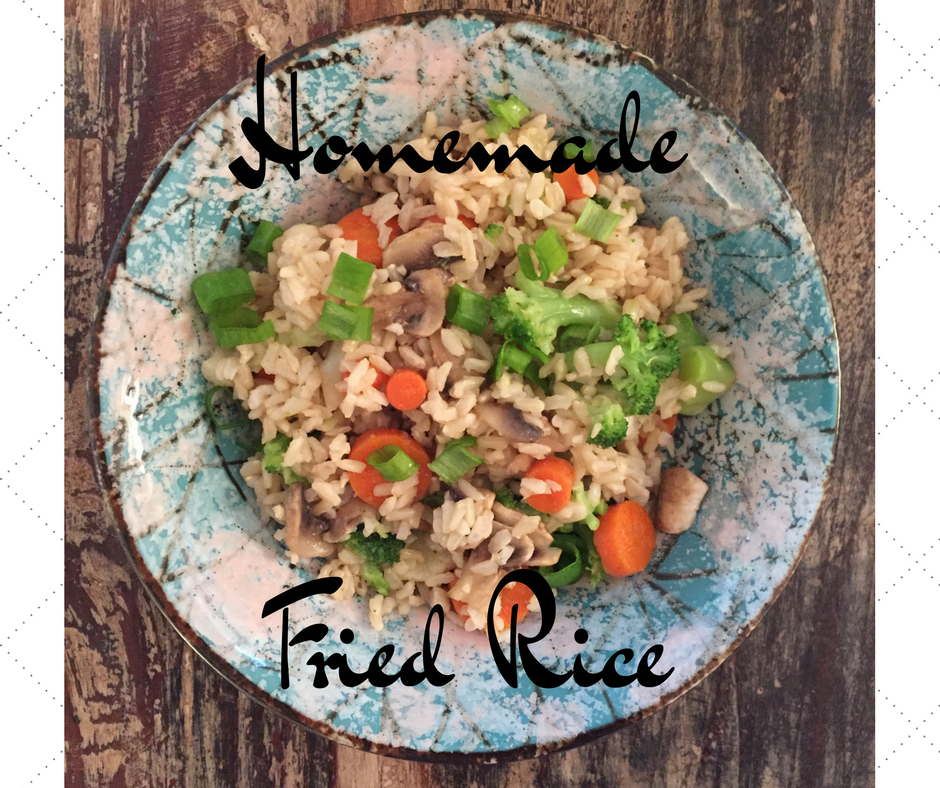90/10 Living + Homemade Fried Rice

Diets are so passé. Living-it is where it’s at. I subscribe to a 90/10 lifestyle which is eating and living healthfully 90% of the time and indulging with no guilt 10% of the time. The potential benefits of this lifestyle are many including weight loss, clear skin, improved mood (no more guilty conscience) and less unhealthy cravings.
Once you start ‘crowding out’ unhealthy processed or trans fat laden foods by incorporating more homemade, whole foods, your 10% ‘cheat foods’ will become healthier, naturally. I used to salivate for store-bought cake but now I crave foods like no guilt no-bake raspberry fudge. I cheat with every meal so my plate normally contains 75-90% colorful vegetables and salad and 10-25% decadent pasta, fried rice, or some other hearty food like lentils or beans. I feel comfortable increasing the ‘cheat foods’ from 10% to 25% in this case because I consider pasta, rice, lentils or beans to be generally healthy foods. Pasta, healthy? Yes! Unless you suffer from celiac disease or have a severe sensitivity to gluten, you can eat pasta in moderation. I like to eat 100% durum semolina pasta. However, if you like wheat, rice or spelt pasta, go for them- they are less processed and certainly better for you. When it comes to rice, brown rice tastes just as good as white rice and contains more fiber, vitamins and nutrients. Organic beans and lentils are delicious, healthy compliments to any meal.
I choose to eat plant-based foods. However, I understand and respect others who choose to eat meat. It is a surprisingly easy transition to become a plant-based foodie if you are so inclined. Contact me if you would like some guidance and support in that area. If you prefer meat to pasta, rice, lentils or beans, just follow the formula of 90% vegetables and 10% meat. I’ve heard that a healthy meat portion is no bigger than the size of one’s own fist. For both health and moral reasons, I highly recommend consuming meat in moderation and choosing meat from pasture-raised animals who were humanely slaughtered, fish that was wild caught and eggs from free range/pasture-raised – maybe not happy, but happier – chickens. Foods labeled ‘organic,’ ‘grass fed’ or ‘cage free’ are not the same as ‘pasture-raised,’ ‘free-range’ or ‘wild caught.’ The concept of Meet Your Meat is important. Certainly, the kinder choice for my carnivorous readers is to choose meat from animals that were pasture-raised or allowed to have free-range and fish obtained by a wild caught method.
Whatever your dietary preference, if you consume more organic, nutrient dense and antioxidant rich fruits and vegetables, you will benefit from having more energy and an improved immune function. The better your immune system functions, the less prone you will be to sickness and disease. I have been a vegetarian for over 25 years. I now prefer – and love – to eat a plant-based diet, aka vegan. However, I was recently at a dinner party and served a decadent plate of cheese complete with figs and fresh-baked bread. I was hungry – hangry actually. I indulged and called it my ‘10%.’ I also made a note to self to bring some Chao Cheese next time. It’s wonderful to watch friends and family enjoying foods like Chao vegan cheese. We really can live a kind life but it does take preparation. What are the health benefits of a plant-based diet? I can only speak for myself. I do not take medicine, have never lacked in protein, maintain a healthy weight without exercise, have clear skin and am told I look younger than my 43 years. I’ll be 44 in about a month, so I’ll take it.
Now let’s indulge in a dish that everyone – carnivore or vegimore – will love.
Ingredients
- 1/2 cup water
- 2 T peanut oil
- 1 onion, peeled and diced
- 2-4 garlic cloves minced (I like a lot of garlic so I use 4 cloves)
- 1 cup broccoli and/or cauliflower, lightly steamed (if frozen, I pour room temperature water over the vegetables just to cover for 10-15 minutes instead of steaming)
- 1 cup sliced mushrooms
- 2 carrots sliced
- 1/2 t sea salt
- 1 cup pre-cooked brown rice
- 1 T toasted sesame oil (regular will do if you can't find 'toasted')
- 2-3 T shoyu - Japanese for soy sauce (I use Bragg Liquid Aminos or Coconut Secret Coconut Aminos in place of soy sauce)
- 1 T mirin - Japanese sweet rice wine (optional)
- 2 scallion stalks chopped
- *as a reminder, organic ingredients are always best. Reach out to me on my Contact page if you have specific questions about what should absolutely be organic and what can be conventional.
Instructions
- Water sauté onion, garlic, carrots and salt until slightly cooked.
- Add broccoli, cauliflower and mushrooms and continue to sauté until all vegetables are just cooked but not overly soft.
- Add the cooked rice. Note, if water has not evaporated, first drain the water before adding the rice.
- Season with peanut oil, sesame oil, shoyu (or aminos) and mirin.
- Garnish with scallions.
- Enjoy!
Using water instead of oil to sauté the vegetables is the healthy choice. While some oils can be heated a high temperatures without becoming carcinogenic (e.g. coconut oil is a safe, high heat oil), it is best for this recipe to add the peanut and sesame oils at the end.
A note on soaking rice: Soaking rice before cooking is a common practice in many countries and has been for centuries. Perhaps that is why they have fewer digestibility issues. Not only does soaking increase the grain’s digestibility but also neutralizes phytic acid which inhibits the absorption of key nutrients like magnesium, calcium, zinc and iron.
Here’s what you do – soak 1 cup rice in 1.5 cups water + 2 tablespoons lemon juice or apple cider vinegar. Soak for 7-8 hours (I usually soak my rice overnight), then drain and cook. In a pinch, I soak for just 10-30 minutes. If you add soaking to your to do list, you’ll be ahead of the game. Practice makes perfect but a list makes life so much easier.




I agree… My “cheat” diet many times is fresh bread with vegan butter or pizza. To compensate, I always accompany them with vegetables, usually, more vegetables than the actual portion of pizza or bread. In this way not only I don’t feel worry but I also feel lighter afterwards and more energetic.
That is exactly what I’m talking about Pelican. Thanks for sharing!